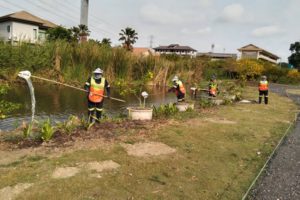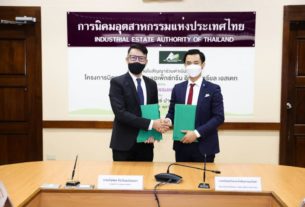
Bangkok keeping it green
BMA makes progress in converting unused spaces into ‘pocket parks’
In the quest to make Bangkok greener and more livable, the Bangkok Metropolitan Administration (BMA) is teaming up with civil groups, private entities and scholars to realise the governor’s flagship policy “15 Minute Pocket Parks” by transforming unused lands in the city into public green spaces.
Bangkok has undergone many changes to keep up with its rapid growth, but as the city grows, it also faces a deficit in public green spaces to provide recreational areas for the citizens and act as the city’s lungs. However, Pornphrom Vikitsreth, an adviser to the Bangkok governor, said the BMA has been working hard to create more public green spaces. Last year, the BMA acquired 107 plots of land to develop as pocket parks under the project.
Parks hard to reach
Like other megacities in the world, Bangkok has big business districts with large buildings, expressways and overpasses that cut across the city. Looking at the city from the air, public green areas in Bangkok are overshadowed by skyscrapers and concrete bridges.
In a total metropolitan area of 1,568 square kilometres, only 32.2 square kilometres can be counted as green spaces, says the BMA’s 2022 green area assessment in Bangkok.
These green spaces are split into seven types of parks: mini or pocket parks, neighbourhood parks, community parks, district parks, city parks, street parks and special-purpose parks, according to the BMA’s Department of Environment.
Considering Bangkok’s estimated population of 10 million, the green space ratio falls to 6.9 square metres per person, about 2.1 square metres short of the minimum ratio of urban green space coverage recommended by the World Health Organization at 9 square metres per individual.
Also, many green spaces in Bangkok are situated between tall buildings, on sidewalks or traffic islands. And the number of available public green spaces does not necessarily imply they can be used for recreational purposes such as exercise or community activities.
The Urban Design and Development Center (UDDC) says that, if considering only public parks which are big enough to provide recreational usage, urban residents in Bangkok have access to them at a ratio of just 0.9 square metre per individual, with parks an average of 4.5 kilometres away, a distance that is difficult to cover by foot.
The BMA’s new administrative team under the leadership of governor Chadchart Sittipunt, under the city’s ambitious “15 Minute Pocket Parks” project, aims to increase public parks coverage in the city and ensure the nearest park is just 800 metres away, or a 15-minute walk.
The BMA’s Department of Environment has defined pocket parks as public parks with an area less than 2 rai, or 0.7 acre, which primarily serve the community within a 1-kilometre radius. Pocket parks are designed as small areas hidden among building complexes or communities, within walking distance of people’s homes.
“We want to increase accessibility to green areas. From anywhere in Bangkok, you should be able to access public parks by foot within 15 minutes, or an 800-metre walking distance,” said Mr Pornphrom.
In a city packed with high-rise apartments, office buildings and shopping malls, building large district parks is impractical, given the lack of accessible green space, he said.
So, the BMA seeks small plots of land in small communities, under overpasses or in between alleys as pocket parks.
Mr Pornphrom said the parks should be provided in all districts, to ensure equal access.
“Initially, the BMA would hunt for publicly-owned or semi-public lands which have not been used and convert them into pocket parks. They can be found under expressways which belong to the Expressway Authority of Thailand (Exat),” he said.
In 2019, the Bangkok Post reported that areas under expressways amount to 1,577 rai, or roughly 92 hectares.
However, about 40% of that land was unused. Exat has occasionally recycled its land under expressways for public use such as cycling routes, children’s playground and sports fields.
Apart from the state-owned lands, the BMA also seeks privately-owned land in Bangkok to develop as pocket parks by offering tax reductions for landowners who are willing to grant the BMA permission to transform them into pocket parks and keep them available for the public for at least seven years.
“We realise that many land plots in the heart of Bangkok are not used for commercial purposes. Landowners often plant banana and lime trees to qualify for a lower tax threshold despite the land’s high commercial value,” he said.
According to the previous land tax rate under the Land and Building Tax Act, land in commercial areas of Bangkok can attract a lower tax rate if they are used for agricultural purposes.
As of January, 13 pocket parks have been opened for public use, while 107 land plots, 27 of which are privately-owned land, have been procured by the BMA to be transformed into new pocket parks in the coming years.
“The BMA aims to create at least 30 parks per year with an annual budget of 30 million baht,” he said.
Self-reliant management

Mr Pornphrom said such a large-scale project like 15-minute Pocket Parks cannot be executed by a local body like the BMA alone.
He demands collaboration from civil groups, private entities and scholars to push policy into action.
Even though the policy is implemented by the BMA and its staff, the ultimate goal of sustaining public green spaces in Bangkok is to make community parks self-reliant.
Yossapon Boonsom, landscape architect and founder of We Park Group, said the public green policy needs more key players.
“Not only do we need tax reduction incentives to attract investors or private entities, we also want more communities and universities to collaborate with us,” said Mr Yossapon.
He said district offices and residents rather than a government body are supposed to attend to the parks.
We Park has teamed up with the BMA to provide arborists, or tree surgeons, to train district office staff to take care of pocket parks, said Mr Yossapon.
“The goal is to let those parks carry on with minor reliance on the BMA. Every Bangkok governor has a four-year term but we want to equip our affiliated parties to run the parks themselves,” added Mr Yossapon.

Small parks also serve environmental and social advantages, the landscape architect said.
“When we think of an urbanised city, we are mostly reminded of skyscrapers. But cities are not all about concrete buildings. They are about nature, too,” Mr Yossapon said.
He said quality of life and public green spaces are intertwined. In a city like Bangkok, public parks are not only places for exercise but also function as carbon sinks which absorb carbon dioxide and mitigate polluted air.
Pocket parks across the city also initiate social groups among communities, bringing people closer together.
“Issues in each area can vary. Some districts need parks to purify the air. Some districts want them to be children’s playgrounds as they have a larger child demographic.
“We should create parks that answer the city’s issues rather than focusing on the number of parks to be created,” said Mr Yossapon.
Note: This story is the last in a series of four special reports about urban development and city planning.
Source: https://www.bangkokpost.com/thailand/special-reports/2515176/city-keeping-it-green


